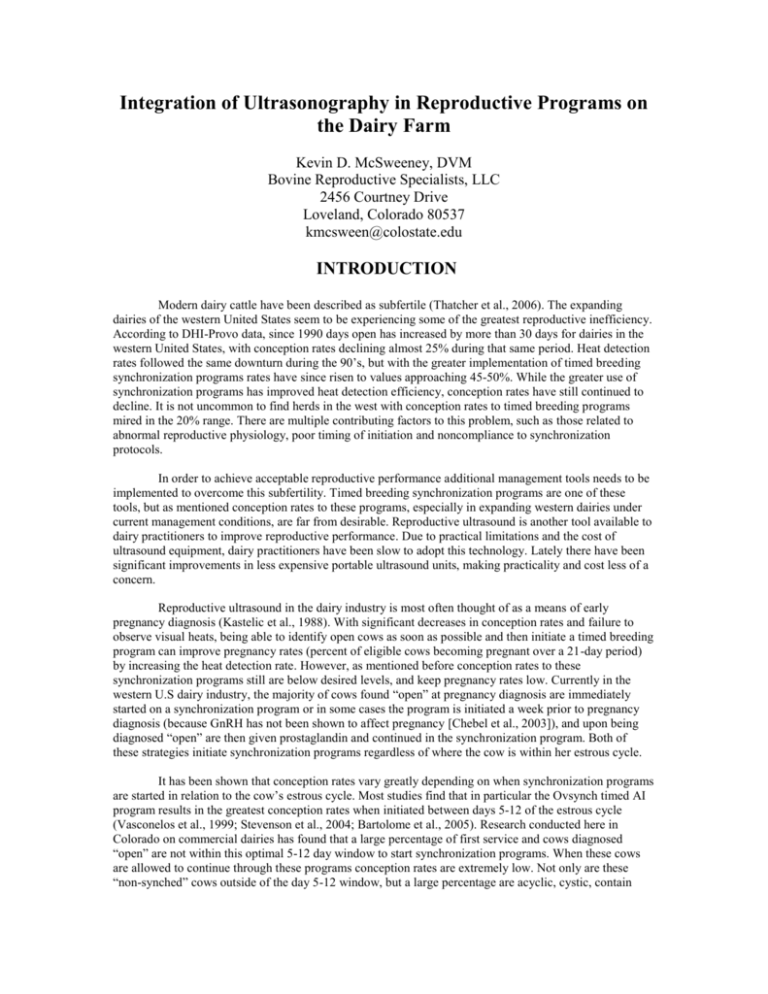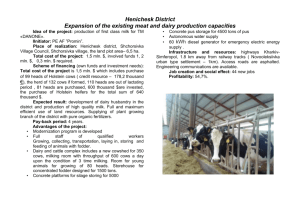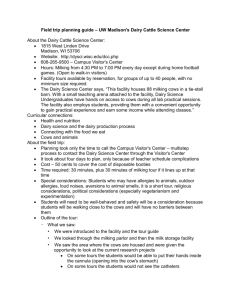Proceedings from lecture given at 2008 Dairy Cattle Reproduction
advertisement

Integration of Ultrasonography in Reproductive Programs on the Dairy Farm Kevin D. McSweeney, DVM Bovine Reproductive Specialists, LLC 2456 Courtney Drive Loveland, Colorado 80537 kmcsween@colostate.edu INTRODUCTION Modern dairy cattle have been described as subfertile (Thatcher et al., 2006). The expanding dairies of the western United States seem to be experiencing some of the greatest reproductive inefficiency. According to DHI-Provo data, since 1990 days open has increased by more than 30 days for dairies in the western United States, with conception rates declining almost 25% during that same period. Heat detection rates followed the same downturn during the 90’s, but with the greater implementation of timed breeding synchronization programs rates have since risen to values approaching 45-50%. While the greater use of synchronization programs has improved heat detection efficiency, conception rates have still continued to decline. It is not uncommon to find herds in the west with conception rates to timed breeding programs mired in the 20% range. There are multiple contributing factors to this problem, such as those related to abnormal reproductive physiology, poor timing of initiation and noncompliance to synchronization protocols. In order to achieve acceptable reproductive performance additional management tools needs to be implemented to overcome this subfertility. Timed breeding synchronization programs are one of these tools, but as mentioned conception rates to these programs, especially in expanding western dairies under current management conditions, are far from desirable. Reproductive ultrasound is another tool available to dairy practitioners to improve reproductive performance. Due to practical limitations and the cost of ultrasound equipment, dairy practitioners have been slow to adopt this technology. Lately there have been significant improvements in less expensive portable ultrasound units, making practicality and cost less of a concern. Reproductive ultrasound in the dairy industry is most often thought of as a means of early pregnancy diagnosis (Kastelic et al., 1988). With significant decreases in conception rates and failure to observe visual heats, being able to identify open cows as soon as possible and then initiate a timed breeding program can improve pregnancy rates (percent of eligible cows becoming pregnant over a 21-day period) by increasing the heat detection rate. However, as mentioned before conception rates to these synchronization programs still are below desired levels, and keep pregnancy rates low. Currently in the western U.S dairy industry, the majority of cows found “open” at pregnancy diagnosis are immediately started on a synchronization program or in some cases the program is initiated a week prior to pregnancy diagnosis (because GnRH has not been shown to affect pregnancy [Chebel et al., 2003]), and upon being diagnosed “open” are then given prostaglandin and continued in the synchronization program. Both of these strategies initiate synchronization programs regardless of where the cow is within her estrous cycle. It has been shown that conception rates vary greatly depending on when synchronization programs are started in relation to the cow’s estrous cycle. Most studies find that in particular the Ovsynch timed AI program results in the greatest conception rates when initiated between days 5-12 of the estrous cycle (Vasconelos et al., 1999; Stevenson et al., 2004; Bartolome et al., 2005). Research conducted here in Colorado on commercial dairies has found that a large percentage of first service and cows diagnosed “open” are not within this optimal 5-12 day window to start synchronization programs. When these cows are allowed to continue through these programs conception rates are extremely low. Not only are these “non-synched” cows outside of the day 5-12 window, but a large percentage are acyclic, cystic, contain dead fetuses or have pyometras, which make them poor candidates to enroll in a synchronization program (McSweeney et al., unpublished data). Ultrasound has the advantage over rectal palpation in being able to completely assess ovarian structures and better predict when cows fall into this “optimum” period to initiate or continue in these synchronization programs (Sprecher et al., 1989). Most important in predicting where a cow is within her estrus cycle is identifying the presence of an active corpus luteum. Ultrasound has been found to be far superior to rectal palpation in predicting an active corpus luteum and high progesterone levels (Bicalho et al., 2008). By using ultrasound, cows can be assessed and synchronization programs can be modified when cows fail to respond to the first GnRH injection. Combining this management tool ultrasound provides with a synchronization program can be a powerful tool to maximize not only heat detection rates but also conception rates which combine to improve overall pregnancy rates. However, the western U.S dairies are also experiencing increased cow to employee ratio, which makes increasing the level of reproductive management a challenge. In order to implement this reproductive management system, dairies will need to increase the number of cattle handled for ultrasound examination, injections and artificial insemination. Only dairies that are capable of handling large number of cattle in a short period of time will be able to incorporate these protocols effectively. Currently most large dairies in the western United States utilize lock-ups to handle cattle. This system requires that cows actively enter and lock themselves, which is not always ideal. Almost 100% of the time this system results in some “loose” cattle that require time to find and lock up. Management/palpation rails were created and gained popularity with the advent of BST. If designed properly, this system can be very efficient in working large number of cattle in a short period of time. Currently on a client’s 10,000 cow dairy we are providing 100% timed artificial insemination. Cattle are handled in a roofed double 40 palpation rail and with 3 ultrasonographers our practice is able to scan 300-450 cows per hour, and using multiple AI technicians we are able to inseminate ~150 cows per hour. By being able to ultrasound, inject and inseminate hundreds of cows in a very short time period, we are able to maintain the time intervals for synchronization and thus maximize conception rates. Only producers that are willing to restructure their reproductive management and build facilities around it will be able to implement these protocols effectively. CONCLUSION Cows have changed so much reproductively over the last 20 years that it takes much more attention to detail and a better understanding of reproductive physiology to get cows pregnant. Producers are reluctant to truly admit that cows have changed, and they still want to manage cows reproductively as if they were in the 1980's. Acknowledging that cows are not the same and then implementing intensive management protocols to overcome these obstacles is critical to improving reproduction. Everything we thought we knew about the reproduction of lactating dairy cows has to be reconsidered. Thinking outside the box and applying new strategies to your reproductive management can pay big returns. Incorporating ultrasound intensively into your timed AI program can improve rates dramatically, but requires a different mindset for managing cows. However, managing reproduction is unlike any other task on the dairy. To succeed, attention to detail has to border on obsessive-compulsive. Synchronization programs require the greatest attention to detail and strict adherence to injection schedules and proper AI technique. Managing high number of cows within these programs also requires strict data entry and retrieval within dairy software programs. So no matter how well the cows are “started” on these programs, if compliance is inadequate results will be inferior. If you don’t strive for perfection in every aspect of reproductive management, you are doomed to poor results. Finding people that have this work ethic and are knowledgeable of reproduction is exceedingly difficult for producers. Other tasks within the dairy industry have been contracted over the years, such as crop production and calf/heifer production. By designing a veterinary practice around the management of reproduction and employing highly skilled individuals to contract all aspects of reproduction from ultrasound, injections, AI to data entry/retrieval can allow for the greatest chance of success when using these synchronization programs and ultrasound on dairies. LITERATURE CITED Bartolome JA, Silvestre FT, Kamimura S, Arteche ACM, Melendez P, Kelbert D, McHale J, Swift K, Archbald LF, Thatcher WW. 2005. Resynchronization of ovulation and timed insemination in lactating dairy cows I: use of the Ovsynch and Heatsynch protocols after non-pregnancy diagnosis by ultrasonography. Theriogenology 63: 1617-1627. Bicalho RC, Galvão KN, Guard CL, Santos JEP. 2008. Optimizing the accuracy of detecting a functional corpus luteum in dairy cows. Theriogenology 70: 199-207. Chebel CC, Santos JEP, Cerri RLA, Galvão KN, Juchem SO, Thatcher WW. 2003. Effect of resynchronization with GnRH on day 21 after artificial insemination on pregnancy rate and pregnancy loss in lactating dairy cows. Theriogenology 60: 1389-1399. Kastelic JP, Curran S, Pierson RA, Ginther OJ. 1988. Ultrasonic evaluation of the bovine conceptus. Theriogenology 29: 39-54. McSweeney KD, Garry F, Olson J, Hirst H, and Seidel GE. Unpublished data. Sprecher DJ, Nebel RL, Whitman SS. 1989. The predictive value, sensitivity and specificity of palpation per rectum and transrectal ultrasonography for the determination of bovine luteal status. Theriogenology 31: 1165-1172. Stevenson JS, Tiffany SM. 2004. Resynchronizating estrus and ovulation after not-pregnant diagnosis and various ovarian states including cysts. J. Dairy Sci 87: 3658-3664. Thatcher WW, Bilby TR, Bartolome JA, Silvestre F, Staples CR, Santos JEP. 2006. Strategies for improving fertility in the modern dairy cow. Theriogenology 65: 30-44. Vasconelos JLM, Silcox RW, Rosa GJ, Pursley JR, Wiltbank MC. 1999. Synchronization rate, size of the ovulatory follicle, and pregnancy rate after synchronization of ovulation beginning on different days of the estrous cycle in lactating dairy cows. Theriogenology 52: 1067-1078.


![[3] Chebel, CC, JEP Santos, RLA Cerri, KN Galvão, SO Juchem, and](http://s3.studylib.net/store/data/006800650_1-f50723bd8d5da504fe0720091a29e0bc-300x300.png)





